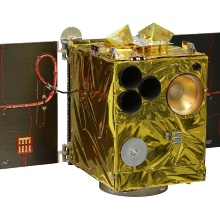The small satellite Flying Laptop from the University of Stuttgart established optical links with the ground station in Tokyo, Japan. In cooperation with the German Aerospace Center (DLR) and the National Institute of Information and Communications Technology (NICT) in Japan, multiple passes over the ground station were executed.
The small satellite Flying Laptop, launched in July 2017, was developed and built by graduate and undergraduate students at the Institute of Space Systems of the University of Stuttgart with support by space industry and research institutions. The mission goals are technology demonstration, earth observation, and serving as an educational satellite. As part of this program, the demonstration of optical links with a body-fixed Laser Terminal was demonstrated again.
"The transmission of satellite data via laser is an exciting new technology. The researchers at the University of Stuttgart Institute of Space Systems are at the forefront of cutting edge science, which is extremely important when it comes to implementing innovations here in the state", said Minister of Science Theresia Bauer.
Previous experiments included successful links with DLR in Oberpfaffenhofen, Germany, and tests with Kongsberg Satellite Services in the south of France. The OSIRISv1 Laser Terminal was developed by the Institute of Communications and Navigation at the DLR. It contains two laser sources with body-fixed collimators. By using optical communication technologies, the instrument provides the possibility to send onboard payload data to Earth.
Throughout the experiments, the satellite needs to point OSIRIS at the ground station while moving with 6.9 km/s past it. On the ground, the telescope needs to point to the satellite as well. Flying Laptop is one of only a few satellites capable of performing optical data downlink from low Earth orbit to a ground station.
During the joint experiment with the NICT, valuable measurement data, such as the received optical power, with which the behavior of the atmospheric transmission channel is evaluated, was recorded. This is useful both for the design of future systems and for the planning of networks. With the wavelength of 1550 nanometers used in the standards, there is only very little measurement data available to date.
“We are pleased that we can help establish and expand the global optical ground station network with the Flying Laptop satellite. It is a great technical achievement to align the laser instrument, and thus in our case the satellite, exactly to one point on earth for the entire duration of a flyover. I am all the more pleased that we have now been able to successfully repeat the transmission tests with many different ground stations," says Prof. Sabine Klinkner, project manager of the Flying Laptop at the Institute of Space Systems at the University of Stuttgart.



